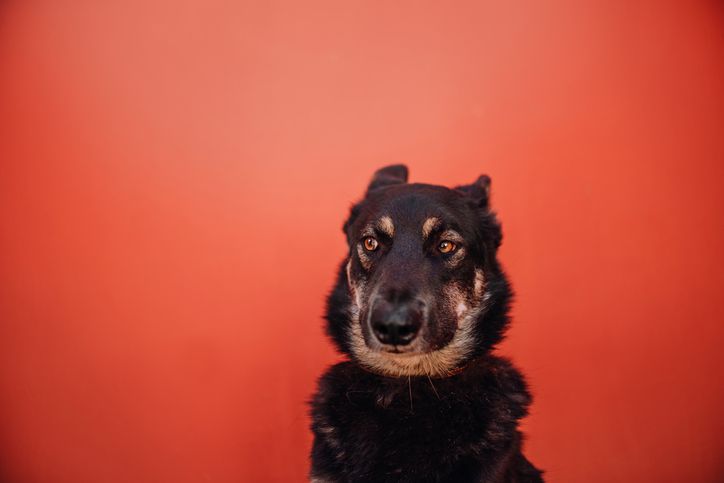When a dog’s ears are back, it indicates fear, anxiety, or submission. This body language suggests that the dog is feeling stressed or uncomfortable.
Observing your dog’s ears can help you understand their emotional state and respond accordingly. Understanding your dog’s non-verbal cues can help you better care for and communicate with your pet. By recognizing the signs that your dog’s ears are back, you can take steps to alleviate their stress and make them feel more at ease.
It’s essential to pay attention to your dog’s body language as it can reveal a lot about their emotional well-being. We will explore what it means when your dog’s ears are back and how to interpret this non-verbal behavior. Understanding your dog’s ears can help strengthen the bond between you and your furry friend.

Credit: www.thewildest.com
Signs Of Fear Or Anxiety
Fear and anxiety are common emotions experienced by dogs, and their body language and vocalizations often provide insight into their state of mind. Understanding the signs of fear or anxiety can help you better support and address your furry friend’s needs.
Body Language
Dogs communicate their emotions through various body language cues, including the position of their ears. When a dog’s ears are pulled back or flattened against their head, it is often a sign of fear or anxiety.
This body language indicates that the dog is feeling threatened or stressed. It is their way of trying to appear smaller to avoid confrontation or danger. Dogs may exhibit this ear position when facing unfamiliar situations, meeting new people or animals, or encountering loud noises.
Additionally, a fearful or anxious dog may also display other corresponding body language signals, such as a lowered body posture, tucked tail, or tense facial expression. It is important to consider these cues as a whole to fully understand your dog’s emotional state.
Vocalizations
Dogs also express fear or anxiety through their vocalizations. When feeling scared or uneasy, dogs may bark, whine, growl, or engage in excessive vocalization.
These vocal cues are their way of communicating distress, seeking attention, or warning others of potential threats. Similarly, the tone and intensity of their vocalizations can vary depending on the dog and the specific situation.
It’s essential to pay attention to your dog’s vocalizations in conjunction with their body language, as this can provide valuable insights into their emotional state. Identifying the triggers that cause fear or anxiety in your dog will help you better address their needs and create a comforting and supportive environment.

Credit: dogmantics.com
Causes Of Ears Being Back
Understanding your dog’s body language is crucial to their well-being. One of the key indicators of your dog’s emotions and physical state is the position of their ears. When a dog’s ears are back, it can signal several underlying causes. It’s important to decipher the reason behind this behavior to address any potential issues and ensure your dog’s comfort.
Fear Or Anxiety
Dogs may pin their ears back when they feel fearful or anxious. This could be due to loud noises, strange environments, or unfamiliar people or animals. It’s essential to create a safe and secure environment for your dog to alleviate their anxiety and provide them with comfort and reassurance.
Submission
Submissive behavior in dogs can also lead to their ears being pushed back. This is often seen when a dog is trying to show deference or surrender to a more dominant individual, whether that’s another dog or a human. Understanding and managing the dynamics within your dog’s social interactions can help minimize submissive behavior.
Pain Or Discomfort
Physical discomfort or pain can cause a dog to hold their ears back. This could be due to ear infections, injury, or other health issues. Regular check-ups with a veterinarian can help ensure your dog’s well-being and address any underlying health concerns.
Interpreting Other Body Language
When it comes to understanding your dog’s emotions and behavior, their body language speaks volumes. One key aspect of deciphering your dog’s feelings is by observing their ear position. In addition to tail wagging and eye contact, a dog’s posture and ear position can give you insights into their state of mind. Let’s explore how to interpret these signs, starting with the position of their ears.
Tail Position
The position of a dog’s tail can be a key indicator of their mood. A wagging tail held high signifies excitement and happiness. A tail tucked between the legs indicates fear or submission. Additionally, a stiffly wagging tail could indicate agitation or potential aggression.
Eye Contact
Eye contact also plays a crucial role in understanding your dog’s emotions. A relaxed, soft gaze suggests contentment, while a fixed, intense stare can signal alertness or a potential challenge. Avoiding eye contact altogether may indicate insecurity or discomfort.
Posture
A dog’s posture can communicate a range of emotions. Arched back and upright stance often portray confidence and a readiness for play. On the other hand, a hunched posture with lowered head signifies submission or anxiety. Observing their overall body language alongside ear position is crucial for a holistic interpretation of their feelings.
How To Help A Fearful Dog
If your dog’s ears are back, it can be a sign that they are feeling fearful or anxious. As a responsible dog owner, it is crucial to understand and address your dog’s emotions to create a safe and comfortable environment for them. By using positive reinforcement training techniques and providing a safe space, you can help your fearful dog overcome their fears and build their confidence.
Creating A Safe Environment
Creating a safe environment for your fearful dog is essential in helping them feel secure and relaxed. Here are some steps you can take:
- Designate a quiet and comfortable area in your home where your dog can retreat to when they feel anxious. This space should be free from any potential triggers that may cause fear or stress.
- Use baby gates or barriers to block off areas of the house that may be overwhelming for your dog. This will help them feel more in control and prevent them from being exposed to situations that may trigger their fear.
- Provide a variety of interactive toys and puzzles to keep your dog mentally stimulated and distracted from their fears. This will help redirect their focus and provide a positive outlet for their energy.
- Consider using a pheromone diffuser or calming aids, such as lavender essential oil, to create a soothing atmosphere for your dog. These natural remedies can help promote relaxation and reduce anxiety.
- Ensure your dog has a comfortable and cozy bed where they can relax and feel safe. Adding familiar scents, such as their favorite blanket or toy, can provide additional comfort and familiarity.
Positive Reinforcement Training
Using positive reinforcement training techniques can help your fearful dog overcome their anxieties and build their confidence. Here are some tips for effective positive reinforcement training:
- Start by identifying the triggers that cause fear or anxiety in your dog. These can be loud noises, unfamiliar people, or certain situations.
- Once you have identified the triggers, gradually expose your dog to them in a controlled and positive manner. For example, if your dog is afraid of strangers, you can start by introducing them to a calm and friendly individual.
- Reward your dog with treats, praise, and affection whenever they display calm and relaxed behavior around the trigger. This positive reinforcement will help your dog associate the trigger with positive experiences.
- Practice regular obedience training with your dog to build their confidence and establish a strong bond between you. This will help them feel more secure and trust your guidance in stressful situations.
- Be patient and understanding with your fearful dog. It may take time for them to overcome their fears, but with consistent positive reinforcement and gentle encouragement, they can make progress.
Remember to consult a professional dog trainer or behaviorist for personalized guidance if your dog’s fearful behavior persists or worsens.
When To Seek Veterinary Help
If your dog’s ears are back, it could indicate fear, anxiety, or submission. In such cases, it’s important to seek veterinary help to understand and address the underlying cause.
Persistent Signs Of Pain
If your dog’s ears are constantly held back and they exhibit signs of pain such as whimpering, yelping, or flinching when their ears are touched, it may indicate a more serious underlying issue. Dogs often display obvious signs of discomfort when they are experiencing pain, and this behavior should be taken seriously. Pain can be caused by various factors such as ear infections, foreign objects lodged in the ear, or even trauma to the ear. In such cases, it is crucial to seek veterinary help promptly to alleviate your dog’s discomfort and prevent further complications.Abrupt Behavior Changes
Another reason to seek veterinary assistance is when your dog’s ears being back is accompanied by abrupt behavioral changes. If your usually friendly and sociable dog suddenly becomes aggressive or lethargic, it could be a sign that something is seriously wrong. Frequently, dogs display changes in behavior when they are experiencing pain or discomfort. These changes may include growling, snapping, or even avoiding interaction with family members or other pets. It is critical to address these behavioral changes promptly as they could indicate an underlying medical condition that requires immediate attention.In conclusion, observing persistent signs of pain or abrupt behavior changes in your dog when their ears are held back is a clear indication that it is time to seek veterinary help. Prompt intervention can help identify any underlying health issues and provide the necessary treatment to alleviate your dog’s discomfort. Remember, a happy and healthy dog is one with ears held high and full of curiosity, so never hesitate to consult a veterinarian when you notice any concerning changes in your dog’s behavior or posture.Credit: www.quora.com
Frequently Asked Questions On What Does It Mean When My Dogs Ears Are Back
Why Do Dogs Put Their Ears Back?
Dogs may put their ears back as a sign of fear, anxiety, submission, or even pain. It’s important to understand your dog’s body language as it can reveal their emotional state and help you address any underlying issues.
Is It Normal For A Dog’s Ears To Be Back?
Yes, it’s normal for a dog’s ears to be back at certain times and in certain situations. However, if your dog’s ears are consistently held back, it could indicate a problem such as fear, aggression, or discomfort. Observe your dog’s behavior and consider seeking advice from a veterinarian if necessary.
How Can I Tell If My Dog’s Ears Are Back Due To Pain?
If your dog’s ears are back and they exhibit other signs of discomfort, such as whimpering, avoidance of touch, or changes in eating or sleeping patterns, it could indicate pain. Consult with a veterinarian to rule out any medical conditions and to determine the appropriate course of action for your dog’s well-being.
Conclusion
Understanding your dog’s body language, including the position of their ears, is crucial for effective communication. When your dog’s ears are back, it often signifies fear, stress, or submission. It’s important to pay attention to other cues to accurately interpret your dog’s emotions.
By being observant and responsive, you can better understand and address your furry friend’s needs. Remember, open communication is key to maintaining a strong bond with your canine companion.



